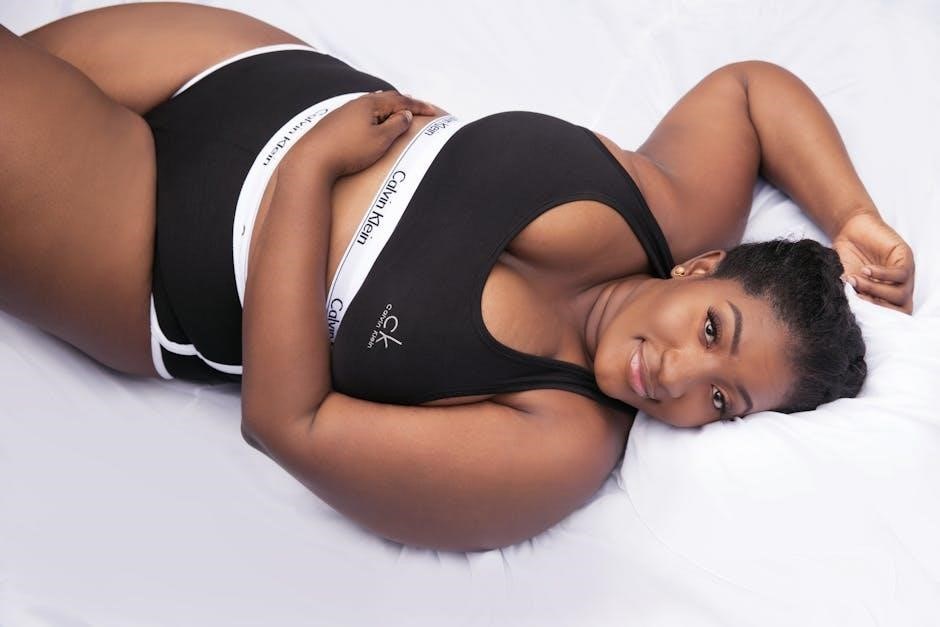Welcome to the ultimate lingerie size guide! Finding the perfect fit can
transform your comfort and confidence. This comprehensive resource provides
everything you need to accurately measure yourself and select the right size
for bras and panties.
Lingerie sizing can often feel like navigating a complex maze, with varying
standards across brands and regions. This introduction aims to demystify the
process, providing you with a clear understanding of how lingerie sizes are
determined. Accurate sizing is crucial not only for comfort but also for the
proper support and shaping that well-fitted lingerie provides. We’ll cover
the basics of bra and panty sizing, highlighting the key measurements you
need to know. Whether you’re a seasoned lingerie enthusiast or new to the
world of delicate undergarments, this guide will equip you with the knowledge
to find your perfect fit.
Importance of Accurate Measurements
Accurate measurements are the cornerstone of finding lingerie that not only
looks beautiful but also feels comfortable and provides the necessary
support. Ill-fitting bras can lead to discomfort, back pain, and poor
posture, while incorrectly sized panties can cause chafing and an unflattering
silhouette. By taking precise measurements, you ensure that your lingerie
fits perfectly, enhancing your natural shape and boosting your confidence.
Furthermore, accurate sizing extends the lifespan of your lingerie, as proper
fit prevents unnecessary stretching or wear. Investing the time to measure
yourself correctly is an investment in your comfort, health, and the longevity
of your delicate garments.
How to Measure Your Bra Size
To determine your accurate bra size, you’ll need a flexible measuring tape.
Wear a non-padded bra that fits you reasonably well. Start by measuring your
underbust, ensuring the tape is snug and level around your ribcage directly
beneath your breasts. Next, measure your bust at its fullest point, keeping
the tape parallel to the floor. Note both measurements carefully. These
numbers will be used to calculate your band and cup size. Remember to stand
naturally and avoid pulling the tape too tight, as this can distort the
measurements. Repeat the measurements to ensure accuracy, and consult a bra
size chart to convert your measurements into a standard bra size.
Underbust Measurement
The underbust measurement determines your bra’s band size, which provides the
primary support. Stand tall and wrap the measuring tape snugly around your
ribcage directly beneath your breasts, ensuring it’s parallel to the floor.
The tape should be snug but not overly tight. Exhale normally to get an
accurate reading. If the measurement is an odd number, round up to the
nearest even number, as bra bands are typically sized in even numbers. This
rounded number is your approximate band size. For example, if you measure 31
inches, round up to 32 inches. Keep this number in mind for the next step,
which involves measuring your bust to determine your cup size.
Bust Measurement
For the bust measurement, wear a non-padded bra that fits well to ensure
accuracy. Wrap the measuring tape around the fullest part of your bust,
keeping the tape level and parallel to the floor. The tape should be snug but
not digging into your skin. Ensure the tape is not too loose, as this will
result in an inaccurate measurement. Take the measurement at the fullest
point of your bust while standing naturally. Note the number where the tape
meets. This measurement will be used in conjunction with your underbust
measurement to calculate your cup size. Accurate bust measurement is crucial
for achieving optimal support and comfort from your bra.
Calculating Cup Size
To calculate your cup size, subtract your underbust measurement from your bust
measurement. The resulting number corresponds to your cup size. For example,
if your bust measurement is 36 inches and your underbust measurement is 32
inches, the difference is 4 inches. This difference corresponds to a D cup.
A difference of 1 inch typically indicates an A cup, 2 inches a B cup, 3
inches a C cup, and so on. Remember that cup sizes can vary slightly between
brands, so it’s always a good idea to consult the specific size chart for
the brand you’re purchasing. Using this calculation, you can determine your
accurate cup size and ensure a comfortable and supportive fit.
How to Measure Your Panty Size
Measuring for your panty size is crucial for comfort and a flattering fit. To
begin, you’ll need a flexible measuring tape. The two key measurements are
your waist and your hips. Your waist measurement should be taken at the
narrowest part of your torso, typically just above your belly button. Keep
the tape level and snug, but not too tight; Next, measure your hips at the
fullest part, ensuring the tape is also level around your body. Record both
measurements in inches or centimeters. Compare these measurements to a panty
size chart provided by the brand you are purchasing from to determine your
ideal size. Remember that sizes can vary, so checking the chart is essential
for the best fit.

Waist Measurement
To accurately determine your waist measurement for panty sizing, locate the
natural waistline. This is typically the narrowest part of your torso,
usually just above your belly button. Stand naturally, and use a flexible
measuring tape to encircle your waist. Ensure the tape is parallel to the
floor and fits snugly, without digging into your skin. It’s important to
breathe normally and avoid holding your breath, which can affect the
measurement. Record the measurement where the tape meets, noting it in inches
or centimeters. This measurement is crucial when comparing your size to
panty size charts, as it helps determine the overall fit and comfort of the
lingerie around your waist area. Remember to check specific brand size charts
for the most accurate fit.
Hip Measurement
To obtain an accurate hip measurement for selecting the correct panty size,
stand with your feet together. Locate the fullest part of your hips and
buttocks. This is usually a few inches below your waist. Wrap a flexible
measuring tape around this area, ensuring the tape is parallel to the floor.
The tape should fit snugly, but not so tight that it compresses your skin.
Check in a mirror to ensure the tape is level all the way around. Record the
measurement where the tape meets, noting it in inches or centimeters. This
measurement is essential for matching your body dimensions with panty size
charts, as it determines the overall fit and comfort around your hips and
rear. Consulting specific brand size charts is crucial for the most precise
fit.
Lingerie Size Charts
Lingerie size charts are essential tools for finding the perfect fit, as sizes
can vary significantly between brands and regions. These charts typically
include measurements for both bra and panty sizes, often presented in US, UK,
and EU standards. Bra size charts correlate underbust and bust measurements
to determine band and cup size, while panty size charts rely on waist and hip
measurements. Consulting these charts ensures that you select lingerie that
not only fits comfortably but also provides the necessary support and
flattering silhouette. Always refer to the specific size chart provided by
the brand you are purchasing from, as slight variations can impact the overall
fit. Understanding how to accurately read and interpret these charts will
greatly enhance your lingerie shopping experience.

Bra Size Chart (US, UK, EU)
Navigating bra sizes across different regions can be confusing, which is why a
bra size chart is invaluable. This chart presents a comparative overview of
bra sizes in the US, UK, and EU systems, allowing for easy conversion. For
example, a 34B in the US is generally equivalent to a 34B in the UK, but may
correspond to an 75B in the EU. The chart lists band sizes (measured in
inches in the US/UK and centimeters in the EU) alongside corresponding cup
sizes (A, B, C, D, DD, etc.). Always cross-reference your measurements with
the chart to identify your correct size in each system, ensuring a
comfortable and supportive fit regardless of the brand’s origin. Keep in mind
that these are general conversions, and individual brand variations may occur.

Panty Size Chart (US, UK, EU)
Similar to bra sizes, panty sizes differ internationally, requiring a
conversion chart for accurate selection. This panty size chart provides a
comparison of sizes across the US, UK, and EU systems. Generally, panty
sizes are based on waist and hip measurements. For instance, a US size Small
might equate to a UK size 8-10 and an EU size 36-38. The chart details
measurement ranges in inches and centimeters for each size, allowing you to
match your measurements to the appropriate size in each region. Always
consider the brand’s specific fit, as variations can occur. Refer to the
chart to ensure you choose the correct size, optimizing comfort and fit for
various panty styles. Note that some brands may use different sizing
conventions.
International Size Conversions
Navigating international lingerie sizes can be challenging due to varying
standards across countries. Understanding international size conversions is
crucial for online shopping and purchasing lingerie while traveling. For bra
sizes, the band size and cup size often differ. A US 34B, for example, may
correspond to a UK 34B, but an EU size might be 75B. Panty sizes also vary;
a US size Medium could be a UK size 12-14 or an EU size 40-42. Online
resources and size conversion charts provide comparisons, but always check
the brand’s specific size guide. Some retailers offer tools to convert your
measurements automatically. Familiarize yourself with the sizing systems in
different regions to ensure accurate purchases and a comfortable fit.
Remember that inconsistencies can occur, so consulting size charts is always
recommended.
Specific Lingerie Types and Sizing Considerations
Different lingerie styles require unique sizing considerations. Bralettes often
use a simpler sizing system (S, M, L) and may not precisely match traditional
bra sizes. Bodysuits and corsets need accurate torso length measurements in
addition to bust, waist, and hip measurements. For bralettes, consider your
band and cup size equivalents to find the closest fit. Bodysuits should fit
snugly but allow comfortable movement. Corsets require precise waist
measurements and may need professional fitting. Shapewear sizing focuses on
compression levels, so choose a size that provides support without
restricting breathing. Bridal lingerie, especially intricate pieces, may have
specialized sizing charts. Always consult the brand’s guide for specific
instructions. Pay attention to fabric composition, as stretchier materials
may allow for more flexibility in sizing. Proper sizing is key to both
comfort and the desired aesthetic effect.
Bralettes
Bralettes offer a more relaxed fit compared to traditional bras, making
sizing slightly different. Many bralettes use standard sizes like Small,
Medium, and Large. To determine your bralette size, refer to the brand’s
size chart, which typically correlates these sizes with bust and band
measurements. If you know your usual bra size, find the corresponding
bralette size on the chart. Consider the bralette’s style; some provide more
support than others. Bralettes with adjustable straps offer greater
customization. If you’re between sizes, consider sizing up for comfort. Pay
attention to the band; it should fit snugly without digging in. Cup coverage
varies, so choose a style that suits your preferences. Keep in mind that
bralettes are designed for comfort, so prioritize a fit that feels natural
and unrestricted. Always check customer reviews for feedback on sizing
accuracy.
Bodysuits and Corsets
Sizing for bodysuits and corsets can be more complex, as they involve
multiple measurements. For bodysuits, focus on your bust, waist, hip, and
torso length. Consult the brand’s size chart, matching your measurements to
the corresponding size. Corsets require precise waist measurements, as this
determines the level of cinching and support. Measure your natural waist,
which is the narrowest part of your torso. Subtract a few inches from this
measurement to determine your corset size, depending on the desired level of
reduction. Bodysuits should fit smoothly without pulling or digging, while
corsets should feel snug but not restrictive. Adjustable closures are
essential for achieving the perfect fit. Consider the material; some fabrics
offer more stretch than others. Always read customer reviews to gauge sizing
accuracy. If you are between sizes, it’s often recommended to size up for
bodysuits and down for corsets. Prioritize comfort and range of motion when
choosing your size.
Fit Guide and Tips
Achieving the perfect fit involves more than just measurements; understanding
how lingerie should feel on your body is crucial. Bras should provide
support without digging into your shoulders or back. The band should sit
snugly around your ribcage, parallel to the floor. Panties should lie flat
against your skin, without creating visible panty lines or feeling too tight.
Consider the style and fabric of the lingerie. Some materials stretch more
than others, affecting the overall fit. Pay attention to the placement of
seams and elastics, as these can impact comfort. Try on different styles to
find what works best for your body shape. When in doubt, seek professional
fitting advice from a lingerie specialist. They can assess your measurements
and offer personalized recommendations. Remember, comfort is paramount.
Lingerie should make you feel confident and supported, not restricted or
uncomfortable. Don’t hesitate to experiment with different brands and sizes
until you find the perfect fit.
Adjustable Straps and Closures
Adjustable straps and closures are key components in achieving a comfortable
and supportive fit, especially for bras. Straps should be adjusted to sit
comfortably on your shoulders without digging in or slipping off. Ensure the
weight of your breasts is evenly distributed between the straps and the band.
Closures, typically hooks and eyes at the back of a bra, allow you to fine-tune
the band’s snugness. Start with the loosest hook and eye and gradually tighten
as the bra stretches over time. Some bras also feature adjustable closures on
the straps themselves, allowing for further customization. For panties,
adjustable side straps or ties can provide a more personalized fit,
particularly for styles like thongs or briefs. These adjustments can help
accommodate fluctuations in weight or body shape. Always check the adjusters
periodically, as they can sometimes loosen with wear and movement. Properly
utilizing adjustable features ensures your lingerie fits perfectly and
provides the support and comfort you need.
Sizing Up vs. Sizing Down
Knowing when to size up or down in lingerie is crucial for achieving the
perfect fit. Generally, if the bra band feels too tight, consider sizing up
in the band while simultaneously decreasing the cup size to maintain the same
overall volume (e.g., going from a 34C to a 36B). Conversely, if the band
feels loose, size down in the band and increase the cup size (e.g., going
from a 36B to a 34C). For panties, if they feel too snug or create
unflattering lines, sizing up may provide a more comfortable and seamless
look. However, if they feel too loose and tend to slip down, sizing down
might be necessary. Keep in mind that sizing can vary between brands and
styles, so it’s always a good idea to consult the specific size chart for the
lingerie you are purchasing. Ultimately, comfort and a smooth, flattering
silhouette should guide your decision on whether to size up or down.